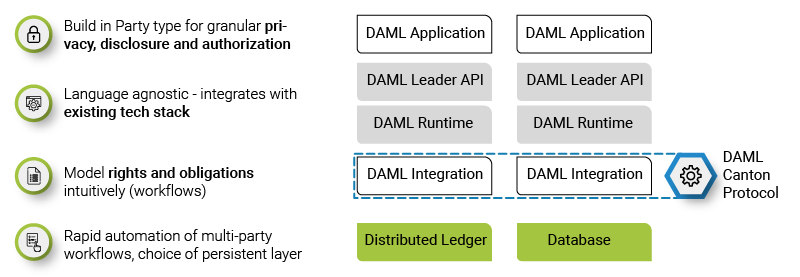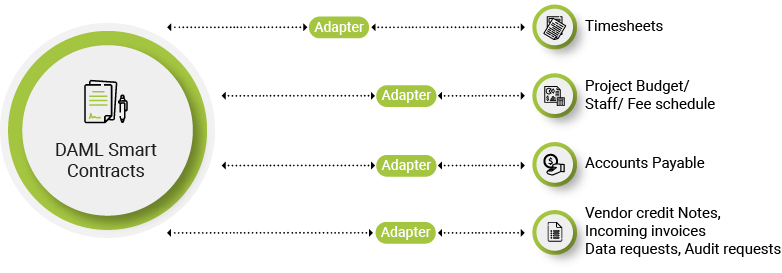Home » Revolutionary use of Smart Contracts to solve your Enterprise Reconciliation and Application Synchronicity Challenges
INSIGHTS
Intelligent solutions. Informed decisions. Unrivaled results.

Revolutionary use of Smart Contracts to solve your Enterprise Reconciliation and Application Synchronicity Challenges
Until recently, your enterprise may have considered smart contracts as a tool to bridge silos from one organization to another - that is to establish external connectivity over Blockchain. However, what if we proposed applying the same concept so a firm can be instrumental in addressing enterprise-wide data reconciliation and system integration / consolidation challenges to expedite time to market and streamline (i.e internal, regulatory, FP&A, supplier risk) reporting.
Afterall, about 70-80% of reconciliation activity takes place within the enterprise. The best part? A firm can do this with minimal disruption to its current application suite, operating system and tech stack. We will look at traditional approaches and explain how smart contracts are the way to get started on one of those journeys when one never looks back
To set the stage, let’s cover the self-evident truths. Reconciliation tools are expensive and third party tool implementations typically require multi year (and multi million dollar) investments. Over 70% of Reconciliation requirements are within the Enterprise amongst internal systems. Most reconciliation resolutions start with an unstructured data input (pdf/email/spreadsheet) which requires a manual review/scrubbing to be ingested easily. For mission critical processes, this “readiness of data” lag can result in delays and lost business, backlogs, unjustifiable cost and worst of all, regulatory penalties.
Magic Finserv proposes a three-fold approach to take on this challenge.
- Data readiness: Tackle the unstructured data solution using AI and ML utilities that can access data sources and ingest them into a structured format. Often Reconcilliation is necessary because of incorrect or incomplete data, ML can anticipate what is wrong / missing from past transactions and remediate. This is the Auto Reconciliation.
- Given unstructured data elements may reside in fragmented platforms or organizational silos, the Firm must have an intelligent way of integrating and mutualizing itself with minimal intervention. An ETL or data feed may look appealing initially, however, these are error prone and do not remediate the manual reconciliation tasks for exception management. Alternatively, a smart contract based approach can streamline your rule-based processes to create a single data source.
- Seamless integration to minimize the disconnect between applications. The goal is to create an environment where reconciliation is no longer required. Ideally.
We have partnered with Digital Asset to outline a solution that brings together an intelligent data extraction tool, a DAML smart contract and a capital markets focused integration partner that will reduce manual end to end reconciliation challenges for the enterprise.
Problem statement & Traditional Approach
Given that most enterprise business processes run through multiple disparate applications with their respective unique databases, it has been proven a monolithic application approach is close to impossible. And not recommended due to issues with a Monolithic application architecture. Traditionally, this challenge has been addressed using integration tools such as an Enterprise Service Bus, SOA, where the business gets consumed in the cycle of data aggregation, cleansing and reconciliation. Each database becomes a virtual pipeline of a business process and an additional staging layer is created to deliver internal/external analytics. In addition, these integration tools are not intelligent as they only capture workflows with adapters (ad hoc business logic) and do not offer privacy restrictions from the outset.
Solution
The Digital Assets DAML on X initiative extends the concept of the Smart Contract onto multiple platforms including Databases. The DAML on X interfaces with the underlying Databases using standard interfacing protocols, the Smart Contract mutualizes the Data Validation rules as well as the access privileges. Once you create a DAML smart contract, the integrity of the process is built into the code itself, and the DAML runtime makes disparate communication seamless. It is in its DNA to function as a platform independent programming language specifically for multi-party applications.

Without replacing your current architecture such as the ESB, or your institutional vendor management tool of choice, use the DAML runtime to make application communication seamless and have your ESB invoke the necessary elements of your smart contract via exposed APIs .
Handling Privacy, Entitlements & Identity Management
Every party in the smart contract has a “party ID” plugged in directly with your identity management solution that you are using institutionally. You can even embed “trustless authentication”.
The idea is that entitlements/rights & obligations are baked directly into the language itself as opposed to a normal business process management tool where you build out your business process and then put the entitlements/ marry them in phase 3 of the process - only to realize that workflow needs to change.
DAML handles this upfront - all of the authentication is taken care of the persistence layer/IDM that you decide on. The smart contract template represents a data scheme in a database and the Signatories/controllers in our example represent role-level permissioning of who can do what/when and who can see what/when
The image below shows how the golden source of data is generated.

It is a purpose built product that contains automatic disclosures and privacy parameters out of the box. You don't need to keep checking your code to see if the guy who is exercising command is actually allowed to see the data or not. All of this is within the scope of the DAML runtime.
Already kickstarted your enterprise blockchain strategy?
Firstly, Amazing! Second, since DAML Smart contracts can run on databases or distributed ledgers of your choice (Fabric, Corda etc. ), it’s a unique solution that gives you the flexibility to get started with the application building and even change underlying ledgers at any point. You can also Integrate between multiple instances. I.e. If you are running a DAML app on Fabric and another DAML app on corda, both apps can talk to one another.
The key takeaway here is that most enterprises are held up with determining which ledger meets their needs. With its intuitive business workflow focused approach, developing your DAML applications while you select your ledger fabric can expedite revenue capture, implement consistent enterprise reporting and reduce the burden of reconciliation - the smart contract through to the integration layer is completely portable.
 Blockchain QA
Blockchain QA
Migrate, implement, test & support multiple enterprise blockchain solutions, efficiently.

